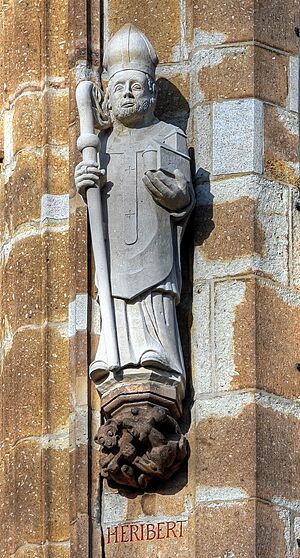Heribert of Cologne facts for kids
Quick facts for kids Heribert |
|
|---|---|
| Archbishop of Cologne | |

Statue at the Cologne town hall tower.
|
|
| Church | Roman Catholic Church |
| Archdiocese | Cologne |
| See | Cologne |
| Appointed | 9 July 999 |
| Reign ended | 16 March 1021 |
| Predecessor | Ebergar |
| Successor | Pilgrim |
| Orders | |
| Ordination | 994 |
| Consecration | 25 December 999 |
| Personal details | |
| Birth name | Heribert |
| Born | c. 970 Worms, Kingdom of Germany |
| Died | 16 March 1021 (aged 50-51) Cologne, Kingdom of Germany |
| Sainthood | |
| Feast day |
|
| Venerated in |
|
| Canonized | c. 1075 by Pope Gregory VII |
| Attributes | Episcopal attire |
| Patronage |
|
Heribert of Cologne (born around 970 – died March 16, 1021), also known as Saint Heribert, was an important German Catholic church leader. He served as the Archbishop of Cologne from 999 until his death. Heribert also worked as a top advisor, called a Chancellor, for the Emperor Otto III starting in 994. Later, he also worked with Emperor Henry II. Heribert was recognized as a saint around the year 1075.
Contents
Early Life and Education
Heribert was born around the year 970 in Worms. His father was Count Hugo, and his mother was Tietwista. He also had a half-brother named Heinrich, who later became the Bishop of Würzburg.
Heribert received his education at two important places. First, he studied at the school connected to the Worms Cathedral. Then, he went to the Benedictine Gorze convent in Lorraine. While studying there, he became friends with Bruno of Carinthia, who would later become Pope Gregory V. Heribert wanted to become a Benedictine monk, but his father did not agree with this choice. So, Heribert decided not to pursue that path.
Becoming a Church Leader
After his studies, Heribert returned to the Worms Cathedral. He became a provost there, which is a senior church official. In 994, he was ordained as a priest by Bishop Holdebold. The Bishop of Worms hoped Heribert would take his place one day.
However, the Emperor Otto III noticed Heribert's talents. The emperor wanted Heribert to join his court as an advisor. This was a very important role in the empire.
Service to the Emperor
In 994, Emperor Otto III appointed Heribert as the Chancellor for Italy. This meant he was a chief minister for the emperor's Italian lands. In 998, he also became the Chancellor for the German kingdom. He held this important position until Emperor Otto III died.
Heribert traveled with the emperor to Rome in both 996 and 997. While he was still in Italy, he received news that he had been chosen to be the Archbishop of Cologne. This was a very high honor. On July 9, 999, in Benevento, he officially became the Archbishop. He received a special scarf called a pallium from the new Pope Sylvester II. On Christmas Day of the same year, he was officially made a bishop in Cologne.
Working with Emperors
In 1002, Heribert was present when Emperor Otto III passed away at Paterno. Heribert then began the journey back to Aachen with the emperor's body and important royal symbols. During this trip, he was captured by Henry II. At first, Heribert did not support Henry II.
However, once Henry II became king in 1002, Heribert accepted him as the new ruler. He continued to serve as Chancellor and worked with the new emperor. Their relationship started off difficult, but Henry II eventually respected Heribert's skills. Over time, their differences turned into a friendship.
Later Years and Legacy
In 1003, Heribert founded the Deutz convent on the Rhine River. This was a religious community that he established. Heribert was known for his kindness and often sent money and help to people in need. He would also send money to priests so they could distribute it to the poor.
Heribert passed away on March 16, 1021, in his archdiocese. He had become ill with a fever while on a visit to a church. He quickly returned to Cologne to recover, but he died within a week. He was buried at his convent church. His remains were moved to a new location on August 30, 1147.
Becoming a Saint
Heribert was highly respected and honored as a saint even during his lifetime. He was officially recognized as a saint, or canonized, around the year 1075. People believed he performed miracles, including ending a long period of dry weather. Because of this, he is often prayed to for helpful rains.
His relics (parts of his body or belongings) were kept in a beautiful golden casket at the convent church in Deutz. Today, this casket is preserved in the parish church of "Neu-St. Heribert" in Köln-Deutz.
Images for kids
See also
 In Spanish: Heriberto de Colonia para niños
In Spanish: Heriberto de Colonia para niños


